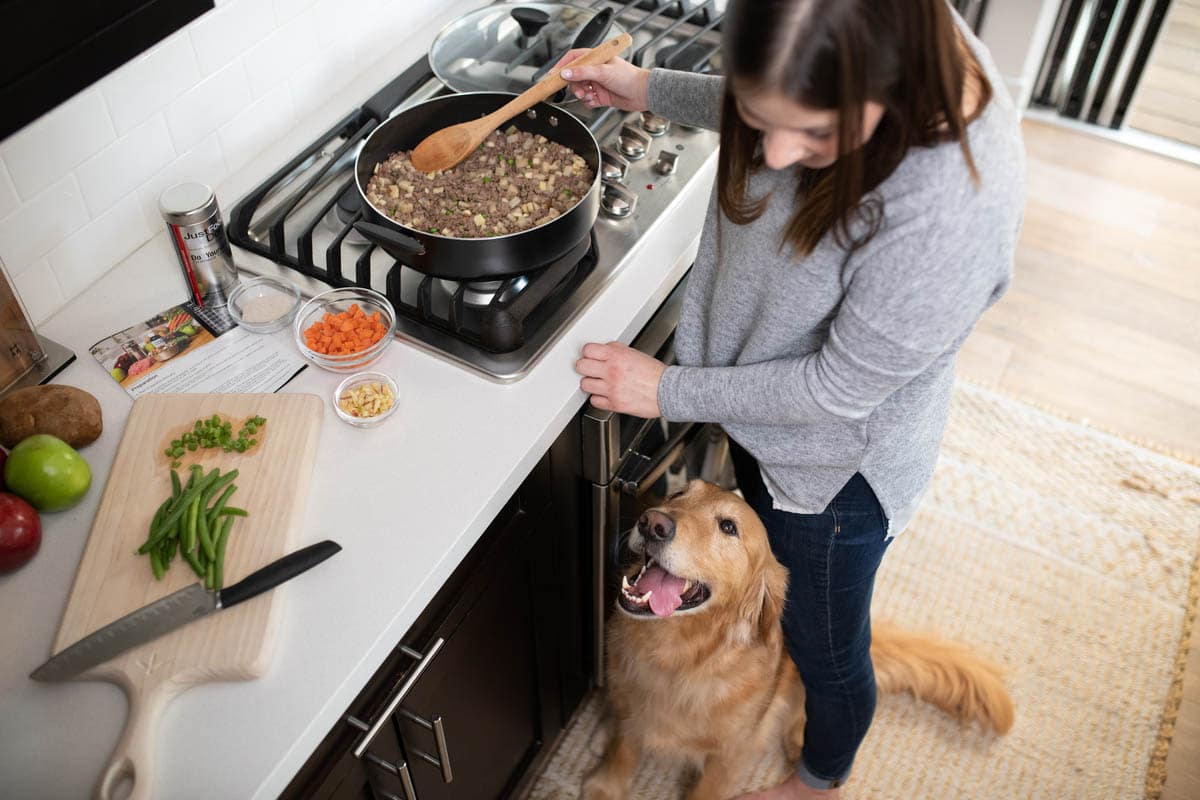Homemade diets for dogs are a safe, viable alternative to highly processed kibble thanks to the nutrition team at JustFoodForDogs. In many cases, premium food is just premium-priced pet food.
The inflated price of “premium” kibbles moved some pet parents to consider making healthy dog food at home using actual food. “Actual food” meaning fresh, high-quality whole food like ground beef, broccoli, zucchini, blueberries, quinoa, green beans, etc. Human-grade, healthy carbs and fresh food ingredients you find at the grocery store. You get it.
University research at Cal Poly Pomona shows that feeding JustFoodForDogs whole food diets improved markers of immune health in 21 dogs. We want all dogs to reap the benefits. For this reason, we compiled useful testimonials and tips for making our recipes in your own home using our DIY kits.
Why We Offer Free, Vet-Approved, Nutritionally Complete Homemade Dog Food Recipes

Shawn Buckley, Founder of JustFoodForDogs said, “We have given away our recipes since the day we opened; our lawyers thought I was crazy – but proper nutrition is so important that we knew it was the right thing to do. People should realize that they aren’t going to be making dinner for Fido every night; most of our customers make their food once or twice a month and freeze it in meal-size portions – the whole thing becomes very easy. The only technically difficult part is the expertise required to make the food nutritionally balanced long-term, and JFFD is proud to share the recipes and make the balancing simple with our DIY kits.”
Like Shawn said, you must meet your dog’s nutritional needs. When making your dog homemade meals, follow recipe instructions carefully to avoid nutritional deficiencies. According to Tufts University Clinical Nutrition Service, the biggest problem with many DIY dog foods or holistic diets made without the guidance of a vet or veterinary nutritionist is that they don’t provide all the nutrients their dog needs.
As you can see, dog nutrition is a delicate balance. Pet parents must follow our recipe instructions exactly as they are written to provide the proper amount of nutrients, carbohydrates, antioxidants, calcium, omega-3 fatty acids, potassium, and the like for their dog’s diet. And when it comes to serving sizes, don’t forget to take the following into consideration:
- Your dog’s life stage (puppy, senior, or adult dog)
- Size and breed
- Activity level
Homemade Diet For Dogs: Tips from Experts

A variety of pet parents are regular users of the DIY homemade fresh dog food recipes. That includes vets and veterinary assistants! These are their pro tips:
- Use a food processor instead of a knife to chop veggies – Jennifer Keating, Registered Veterinary Technician and veterinary student on the East Coast.
- No meat grinder? Most butchers will grind raw food ingredients for ground meat at no additional charge (organ meat like chicken liver, beef liver, etc) – Dr. Laura Searle-Barnes, a veterinarian at Estrella Veterinary Hospital in San Clemente, CA.
- Get some large pots and pans for cooking the potatoes in larger quantities so that you can make food once or twice a month, and save time. In addition, cooking the veggies with the protein makes clean up very easy, says Stephen Douglas, Dr. Laura’s husband – making their own dog food for their two pups has become a fun family routine.
- Buy proteins in bulk: It’s all about volume because you are making large amounts at cook time, so buy proteins in bulk at Costco and store it in the freezer. Buy your potatoes and starches in large 5- to 10-pound bags and store them in a dry, cool, dark place. – Sayaka Nakamura, a veterinary assistant in Southern California.
- Try cooking in a Crockpot: No stove? JFFD DIY kits come with both Crockpot and Instant Pot cooking instructions.
Sayaka’s Money-Saving Hacks
Sayaka found the home cooked dog food concept because her dog Bella has Inflammatory Bowel Disease (IBD). Unfortunately, this is a condition that many of today’s dogs have developed. Possibly due to some of the feed-grade ingredients found in most commercial dry dog food. Advised to make a homemade diet using the DIY Fish and Sweet Potato recipe, Sayaka’s dog has had excellent results. And Bella loves the food!
When Sayaka first bought the human food ingredients for the recipe, they cost her about $45. The biggest cost was mainly the proteins (in her case white fish). However, by the time she made her second batch, she got the cost down to $25 — almost half — with a little shopping around.
The cost of Pacific Cod fillet is about $9/lbs in her area, but at a Trader Joe’s near her, they sell Wild Caught Cod Pieces for $3.99/lbs. That’s huge savings for the same quality fish! And since the fillets are cut up anyway – the chunks are a bonus! Sayaka also recommends farmer’s Chinese markets for starches and vegetables!
Both Sayaka and Stephen recommend walking up to the grocery or local butcher and asking for the manager’s specials. These are meats that they may still have in large quantities that must be used that day or the next day, but are otherwise of great quality. Because the food will be cooked soon, then frozen – these largely discounted meats are perfect for this use.
Cost Benefits of a Homemade Diet For Dogs
Following these tips, dog owners can achieve significant savings on the most expensive ingredients (meats and proteins). This can save you almost 50% on the cost of making nutritious food for your pets.
Sayaka says that in the end, $25 for 10 lbs of food costs the same as a bag of kibble. But the quality, nutrition, and mealtime love may be worth much more.
Watch the following video to learn more about JustFoodForDogs cooked dog food and how to prepare them for your doggy.
Related reading:
Try This Healthy Dog Treat Recipe
Superfoods for Your Dog’s Health
Dog Supplements for Homemade Food
Click one of the fresh dog food recipes below for a handy printable PDF:
- Lamb & Brown Rice
- Ground Turkey & Whole Wheat Macaroni
- Ground Beef & Russet Potato
- Venison & Butternut Squash
- Chicken & White Rice
- Fish & Sweet Potato
This content is for informational use only and does not replace professional nutrition and/or medical advice, diagnosis, or treatment. It is not a substitute for and should not be relied upon for specific nutrition and/or medical recommendations. Please talk with your veterinarian about any questions or concerns.
